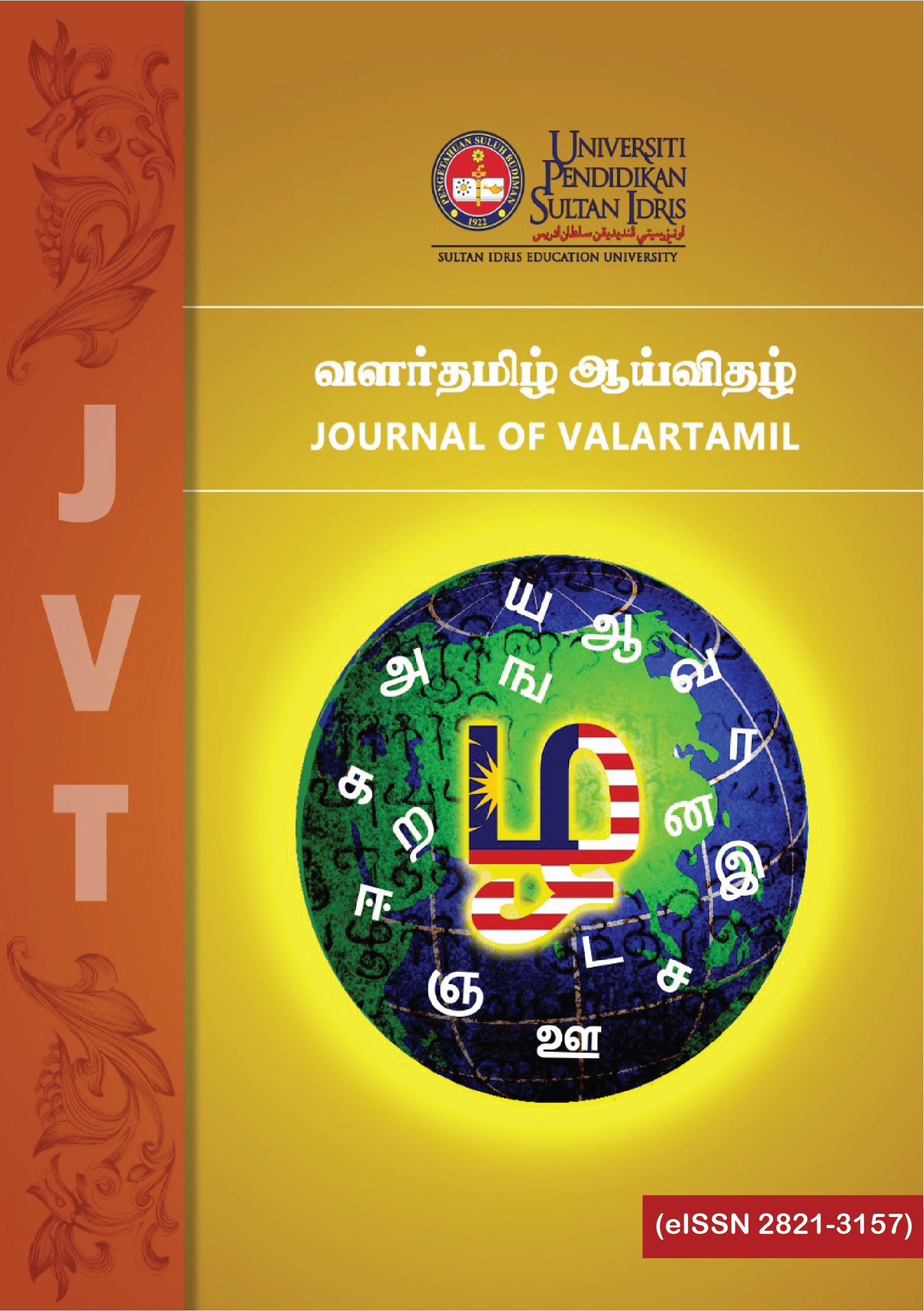மூன்றாம் ஆண்டு மாணவர்களின் லகர ழகர ளகர எழுத்துகளைச் சரியான உச்சரிப்புடன் வாசிக்கும் திறனை மேம்படுத்த QR குறியீட்டுத் தகவல் தொழில்நுட்ப முறையிலான வாசிப்புச் சிப்பம்
Qr Coded Information Technology Reading Module to Improve Third Year Students Reading Skills with Correct Pronunciation of La, Ḻa, Ḷa in Tamil Language
DOI:
https://doi.org/10.37134/jvt.vol2.1.3.2021Keywords:
தரவு, தேவைகள், மதிப்பீடு, வடிவமைப்பும் மேம்பாட்டும், வாசிப்புச் சிப்பம்Abstract
மூன்றாம் ஆண்டு மாணவர்களின் லகர, ழகர, ளகர எழுத்துகளைச் சரியான உச்சரிப்புடன் வாசிக்கும் திறனை மேம்படுத்த QR குறியீட்டுத் தகவல் தொழில்நுட்ப முறையிலான வாசிப்புச் சிப்பத்தை உருவாக்குவதை இந்த ஆய்வு நோக்கமாகக் கொண்டுள்ளது. இந்த ஆய்வை மேற்கொள்ள ரிட்சே, கிலென் (Ritchey and Kilen, 2007) அறிமுகப்படுத்திய வடிவமைப்பும் மேம்பாட்டு (Design Development Research) ஆராய்ச்சி அணுகுமுறையும் பயன்படுத்தப்படுகிறது. இந்த ஆய்வு மூன்று கட்டங்களாகப் பிரிக்கப்பட்டுள்ளன. முதல் கட்டத்தில் தேவைகள் அடிப்படையில் (Need Analyse) எட்டு தமிழ்மொழி ஆசிரியர்களுடன் நேர்காணல் செய்யப்பட்டுத் தரவுகள் சேகரிக்கப்பட்டன. பிறகு, 84 மாணவர்கள் ஆய்வுக்கு உட்படுத்தப்பட்டனர். கேள்வித் தாள்களைப் பயன்படுத்தி மாணவர்களின் தேவைகளின் பகுப்பாய்வு மதிப்பிடப்பட்டது. புள்ளிவிவரத் தொகுப்பைப் (SPSS) பயன்படுத்தி விளக்கப் புள்ளி விவரங்கள் மூலம் பெறப்பட்ட தரவுப் பகுப்பாய்வு செய்யப்பட்டது. இரண்டாவதாக வடிவமைப்பு மற்றும் மேம்பாடு கட்டத்தில் (Product Development And Design) வாசிப்புச் சிப்பத்தை உருவாக்க ஃப்சி டெல்பி (Fuzzy Delphi) முறை பயன்படுத்தப்பட்டது. மூன்றாம் கட்டத்தில், மதிப்பீடு (Evaluation) நிபுணக் குழு அணுகுமுறையைப் பயன்படுத்தி 10 பேர் கொண்ட ஆசிரியரும் விரிவுரையாளரும் கொண்ட குழுவினரால் வாசிப்புச் சிப்பத்தின் பயன்பாடு மதிப்பீடு செய்யப்பட்டது. மாணவர்களின் லகர, ழகர, ளகர உச்சரிப்பு வாசிப்புத் திறனின் முன்னறிவு சராசரி மதிப்பு 4.06 (SP:0.5), மாணவர்களின் லகர, ழகர, ளகர உச்சரிப்பு வாசித்தலின் அணுகுமுறைநிலை 4.37 (SP:0.492) மற்றும் மாணவர்களின் லகர, ழகர, ளகர உச்சரிப்பு வாசித்தலின் தயார்நிலை 4.41 (SP:0.45). வடிவமைப்பும் மேம்பாட்டில், வாசிப்புச் சிப்பத்தின் குறிக்கோள்கள், உள்ளடக்கம், பயிற்றுத்துணைப்பொருள்கள், கற்பித்தல் உத்திகள் அடங்கியுள்ளன. மேலும், வாசிப்புச் சிப்பத்தை உருவாக்குவதற்கான மதிப்பீடு ஆகியவற்றைக் கொண்ட முக்கியக் கூறுகளை உள்ளடக்கியது. மூன்றாம் கட்டத்தின் அனைத்து முக்கியக் கூறுகளும் 84%க்கும் அதிகமான சதவீத மதிப்பை அடைந்துள்ளன. ஆய்வுக்கு உட்படுத்தப்பட்ட 40 மாணவர்கள் மற்றும் கட்டுப்பாட்டுக் குழுவில் உள்ள 40 மாணவர்கள் மீது வாசிப்புச் சிப்பம் பயன்படுத்துவதற்கு முன்னும் பின்னும் சோதனைகள் மேற்கொள்ளப்பட்டன. வாசிப்புச் சிப்பத்தைப் பயன்படுத்திய பின் மாணவர்களின் சோதனைக்கு முன் மதிப்பெண்கள், சோதனைக்கு பின் மதிப்பெண்களை விட அதிகமாக இருந்தன என்று ஆய்வின் முடிவுகள் காட்டுகின்றன. ஆகவே, ஆசிரியர்களும் மாணவர்களும் சரியான லகர, ழகர, ளகர உச்சரிப்புடன் வாசிப்புத் திறனை மேம்படுத்துவதில் QR குறியீட்டுத் தொழில்நுட்ப வாசிப்புச் சிப்பம் வழிகாட்டியாக உள்ளது.This study aimed to develop a reading module based on QR Barcode technology to improved reading skill with correct pronunciation of la, ḻa, ḷa among Year Three students. This study is based on Design and Developmental Research Approach introduced by Ritchey and Kilen (2007) to develop the module. This study is divided into three phases. The first phase involved analysis of eight teachers those who are interviewed through semi-structured questions. Analysis of students needs is assessed using questionnaires involved 84 pupils. Data obtained analysed through descriptive statistics using SPSS. The second phase used Fuzzy Delphi (FDM) method to develop the module. The third phase involved assessment of the module’s usability by 10 experts using Modified Technique Group Approach. The mean value of students’ knowledge level is 4.06 (SP:0.5), attitude level 4.37 (SP:0.492) and readiness level 4.41 (SP:0.45). Findings from the second phase involved main components consisting of objectives, content, tools, teaching strategies and evaluation to develop the module. The findings of the third phase showed that all the main components and its elements achieved percentage value of more than 84%. Pretest and post-tests were performed among 40 students in treatment group and 40 students in the control group before and after the use of the reading module. Implication of this study was module will be a guide for teachers and students in improving reading skills with correct pronunciation in SJKT.
Keywords: Data, Design and Development, Evaluation, Need Analyze, Reading Module
Downloads
References
Abd. Ghafar Md. Din. (2003). Prinsip dan Amalan Pengajaran. Kuala Lumpur: Utusan Publication & Distributors Sdn. Bhd.
Buku Panduan Tatabahasa Ceyyul Dan Mozhiyani (SJKT). (2018) Bahagian Pembangunan Kurikulum Kementerian Pendidikan Malaysia.
Chandragantham, P. (2008). 200 a:ndukalil Male:ciya. Kuala Lumpur: Uma Publications.
Chang, P. T., Huang, L. C., & Lin, H. J. (2011). The Fuzzy Delphi method via fuzz statistics and membership function fitting and an application to the human Resource. Fuzzy Sets and Systems,112(3), 511–520.
Che Zanariah Che Hassan Fadzilah ABD Rahman. (Mei 2011). Pelaksanaan Pengajaran dan Pembelajaran Menulis di Sekolah Rendah.
Creswell, JW. (2009). Research design:Qualitative, quatitative, and mixed methods Approaches. (3rd ed). Los Angles:Sage.
Deslandes, S.F, Mendes, C.H.F, Pires, T.O & Campos, D.S. (2010). Use of the Nominal Group Technique and the Delphi Method to draw up evaluation indicators for strategies to deal with violence against children and adolescent in Brazil, Rev. Bras. Saude Matern. Infant Recife, 10 (1), 29-37.
Dhandayutham R,1973 (1992-1983), Malayavil Tamil Kalvi (Tamil), University Chennai, Madras.
Merriam, S. B. (2001). Qualitative research and case study applications in education. San Francisco, CA: Jossey-Bass.
Paranthamanar, A.K. (1984). Nalla TamiL eLutha ve:nduma. Chennai: Pa:ri Nilaiyam. Pelan Pembangunan Pendidikan Malaysia 2013- 2025. Putrajaya: Kementerian Pelajaran Malaysia.
Pelan Induk Pembangunan Pendidikan (PIPP) 2006-2010. Kementerian Pendidikan Malaysia.
Richey, R.C. & Klein, J. D. (2007). Design and Development Research:Methods, Strategies,and Issues. Mahwah, NJ: Lawrence Erlbaum Associates.Rouillard, J. (2008, July). Contextual QR codes In Computing in the Global Information Technology, ICCGI'08. The Third International Multi-Conference Greece, Athens.
Siti Hajar Abdul Aziz (2009). Bahasa Melayu II. Selangor. Oxford Fajar Sdn.Bhd.
Siti Hajar Halili & Suguneswary. (2016). Penerimaan guru terhadap penggunaan teknologi maklumat dan komunikasi berasaskan Model TAM dalam pengajaran mata pelajaran bahasa Tamil. Jurnal Kurikulum & Pengajaran Asia Pasifik, 4(2), 31- 41, April.
Yennah Juakim. (2013). Hubungan sikap, minat dan pengajaran guru dengan pencapaian akademik dalam mata pelajaran matematik di kalangan pelajar di Sekolah Menengah Kota Marudu, Sabah. Universiti Malaysia Sabah.





